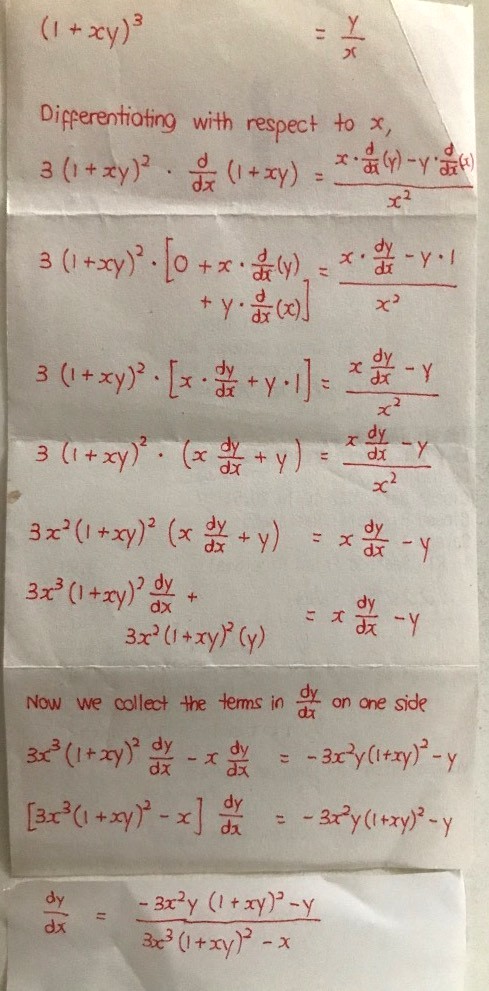Eric Nicholas K's answer to LockB's Junior College 1 H2 Maths Singapore question.
done
{{ upvoteCount }} Upvotes
clear
{{ downvoteCount * -1 }} Downvotes
We continue to perform differentiation as usual using regular rules, but this time we do not attempt to make y the subject as we perform the differentiation.
Whenever you perform differentiation last year, in Sec 4,
y = x^2
dy/dx = 2x
What we are actually doing is
y = x^2
d/dx (y) = d/dx (x^2)
The process of writing dy/dx actually has this intermediary step of taking “d/dx” on both sides of the equation.
This is actually what happens for our question - we take d/dx on both sides, and whenever we see a “d/dx (y)”, it becomes dy/dx.
Whenever you perform differentiation last year, in Sec 4,
y = x^2
dy/dx = 2x
What we are actually doing is
y = x^2
d/dx (y) = d/dx (x^2)
The process of writing dy/dx actually has this intermediary step of taking “d/dx” on both sides of the equation.
This is actually what happens for our question - we take d/dx on both sides, and whenever we see a “d/dx (y)”, it becomes dy/dx.
Date Posted:
1 year ago
i dont really understand whats going on before the "now we....." tho
sorry for late reply i didnt get any notifications from the app
sorry for late reply i didnt get any notifications from the app
ohhh i get it now
also, when we differentiate 3y, do we write it as 3(dy/dx) or just dy/dx?
since d/dx(y) = dy/dx, but now theres a 3 infront and im not sure how to deal with it...
if uts d/dx(3x) its just 3 but i dont think d/dx(3y)=3
also, when we differentiate 3y, do we write it as 3(dy/dx) or just dy/dx?
since d/dx(y) = dy/dx, but now theres a 3 infront and im not sure how to deal with it...
if uts d/dx(3x) its just 3 but i dont think d/dx(3y)=3
d/dx (3y)
= 3 times d/dx (y)
= 3 times dy/dx
= 3 dy/dx
dy/dx is in fact an expression for d/dx (y)
In general, whenever you do the differential of something which is y, we do everything the same as though it is an x, but we add an extra dy/dx behind as part of the chain rule
Eg
d/dx (10x^2) = 20x
d/dx (10y^2) = 20y times dy/dx
NOTE: d/dy (10y^2) = 20y without the dy/dx
= 3 times d/dx (y)
= 3 times dy/dx
= 3 dy/dx
dy/dx is in fact an expression for d/dx (y)
In general, whenever you do the differential of something which is y, we do everything the same as though it is an x, but we add an extra dy/dx behind as part of the chain rule
Eg
d/dx (10x^2) = 20x
d/dx (10y^2) = 20y times dy/dx
NOTE: d/dy (10y^2) = 20y without the dy/dx



